How To Finish A Garage Ceiling
Garage Remodel Tips
Updated: Oct. 22, 2019
Convert your drafty, dingy, spider-infested garage into a bright, comfortable work infinite
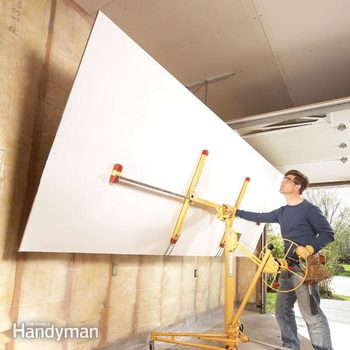
Transform your garage into a room by calculation wiring, insulation and wall covering. A finished garage can become a workshop, mechanic's infinite, play space or fifty-fifty a individual den.
You might also similar: TBD
Garage Remodel: Add blocking and framing
Almost rough-framed garages aren't fix for drywall. Your garage may be missing studs at the corners and attachment points for the ceiling drywall. To see where framing members may exist missing, inspect inside corners where walls meet and where the walls see the ceiling. These are the most common areas needing additional framing. These two photos bear witness how to add together ceiling blocking.
While the framing is accessible and you have your carpentry tools out, you may want to add other framing or structural elements. Here's a listing of possibilities:
- Add blocking between studs for attaching shelving.
- Nail blocking between ceiling trusses for hanging lights, cord reels or bicycle hooks.
- Frame an opening for an attic access hatch.
- Frame a ceiling opening for a drop-down attic ladder.
- Cut a hole and frame an opening for a through-the-wall air-conditioning unit.
- Add windows or skylights.
Caution!
Turn off ability before working on wiring.
Garage Remodel: Reroute wiring and add together outlets
Most unfinished garages have the blank minimum of outlets and lights, then you'll want to add a few. And in some cases, you'll have to reroute wiring that's attached to the face of studs or the underside of ceiling framing. Nosotros had to reroute phone wires, door opener control wires and plastic-sheathed cable in our garage. Remove surface-mounted wiring and movement it into the stud space, or reroute it over the top of the ceiling joists or trusses.
You may take to drill holes through studs or through the top plate of walls to reroute wires. If so, exist sure to center the holes on the stud. If the plastic-sheathed cables are too short to accomplish the next box when yous reroute them, yous can add a junction box and splice on a length of cable. The new box must be accessible either in the attic infinite or through a blank cover on the wall or ceiling.
This is also a expert time to add outlets, lights and even some other twenty-amp circuit for power tools. Figure A shows some wiring improvements to consider.
Call the local building inspections department to get a permit before you add or alter wiring, and have the wiring inspected before you embrace it with drywall or insulation. Not upwards for doing the wiring yourself? Extra outlets and good lighting are well worth the toll of hiring an electrician.
Figure A: Plan Your Electrical Needs
Draw a sketch of where piece of work areas, appliances and electrical devices will fit before beginning the wiring.
Garage Remodel: Ventilate and insulate
An insulated garage will stay libation in the summertime and warmer in the wintertime. The kickoff stride is to be sure the attic is well ventilated. Check to see how many attic and roof vents you lot have. A good rule of thumb is a total of ane sq. ft. (144 sq. in.) of vent opening per 300 sq. ft. of cranium divided between the soffit and roof vents. For a typical 20 x 22-ft. garage, you'd need virtually six 4-in. x 12-in. soffit vents and ii standard foursquare roof vents. Brand sure your ventilation is effective past installing vent chutes between the trusses. Vent chutes have a channel that prevents blown insulation from blocking the airflow from the soffit vents to the attic space. Plug the surface area under the vent with wood blocking or plastic and a chunk of fiberglass insulation to forbid wind from blowing up through the insulation or insulation from filling the soffit.
We recommend filling the stud spaces with friction-fit fiberglass batts, covering the walls and ceiling with a iv-mil poly vapor retarder, and blowing insulation (cellulose insulation is a good choice) into the attic after the ceiling drywall is installed.
Showtime by insulating the walls. Buy unfaced R-thirteen batts for two×4 walls and unfaced R-19 batts for 2×6 walls. Match the width of the batt (15-one/four in. or 23-1/4 in.) to the stud space. Cut batts carefully for a tight fit. Side by side, staple four-mil poly to the walls and ceiling. Embed the poly sheeting in caulk around the perimeter of each slice to create an closed seal. Seal the seams between sheets and seal the poly to electrical boxes with caulk or special sheathing record (it's typically red and looks like packing tape).
After the drywall is installed on the ceiling, you tin can blow insulation into the attic. Home centers and some rental stores sell blow-in–type insulation and often offer free or reduced charge per unit rental on the blower if you purchase insulation from them.
Garage Remodel: Atmospheric condition-strip doors and windows
Leaky doors and windows permit in uncomfortable drafts and increase heating and cooling costs. Check your garage service door to be sure it has good weather stripping and a threshold that seals tightly to the bottom of the door. In almost cases, if your service door is missing a threshold and weather stripping, it's more efficient to replace the door with a new, weather-tight version. You can buy an inexpensive prehung metal exterior door at dwelling house centers and lumberyards.
The overhead garage door can be a big source of drafts and estrus loss. Recently installed doors usually include a atmospheric condition-stripped terminate effectually the perimeter. Only older doors may be lacking a weather condition strip. Luckily, it'southward an easy set up. Garage door weather stripping is available at abode centers and hardware stores, and installation is straightforward. If your overhead door is uninsulated, search online for "garage door insulating kits."
Garage Remodel: Terminate up with drywall
Drywall is the easiest and about economical covering for your garage ceiling. Use five/viii-in.-thick drywall if your trusses or rafters are spaced 24 in. apart. We'll show you a few tips to simplify drywall installation.
Before y'all install the drywall, temporarily remove the brackets that support the garage door tracks and opener. This will make it easier to install the iv-mil poly and ceiling drywall and will result in a neater-looking chore. Offset by advisedly measuring and recording the position of the tracks and opener. Measure from the nearest wall and from the floor. And so close the garage door, lock it closed and unplug the opener to disable it. Unscrew or unbolt the brackets that support the garage door tracks and remove them. Also remove the garage door opener brackets and support the opener on a ladder. Information technology may exist easier to entirely disconnect the opener and set it aside. Reinstall the garage door track brackets using a new section of angle iron on the ceiling. Attach each new ceiling angle iron with 4 five/sixteen-in. ten 3-in. lag screws driven into the centre of the ceiling joist or into wood blocking that'south screwed to the adjacent ceiling framing.
The second tip that'll simplify the drywalling job is to hire a drywall lift. They're available at well-nigh rental centers. For ceiling work, load the sail onto the lift vertically and then swivel the lift platform until the canvass is horizontal. So crank the canvass to the ceiling while you lot gyre it into position. The lift also works for walls.
DIY Success Stories
The smartest affair I did in my garage was to add lots of outlets. I put them loftier on walls, depression on walls, even a few switched outlets in the ceiling to power plug-in type fluorescent lights. Fourteen outlets in all! My wife thought I was nuts, but I've never regretted it. No matter what I'k doing, piece of cake-access power is right there. Terry Wiley
I covered my garage walls with five/eight-in. OSB instead of drywall. Information technology costs more and doesn't look quite every bit good. Merely it looks fine with a few coats of pigment, and I didn't have to sand drywall mud (which I hate!). Improve yet, I tin mount pegboard, brackets or hooks anywhere. No need to chase for studs. Phil Burkard
Required Tools for this Projection
Have the necessary tools for this DIY project lined up earlier you outset—you'll salvage time and frustration.
Yous'll also demand a drywall lift.
Required Materials for this Project
Avoid final-minute shopping trips by having all your materials ready ahead of fourth dimension. Here's a list.
Originally Published: June twenty, 2017
Source: https://www.familyhandyman.com/project/garage-remodel-tips/


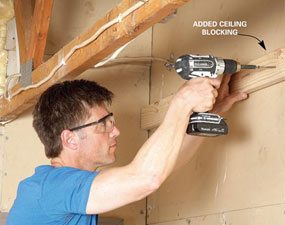
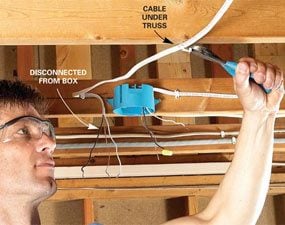
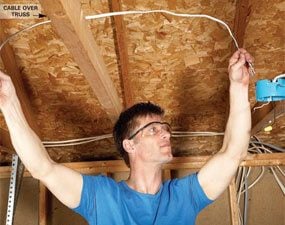
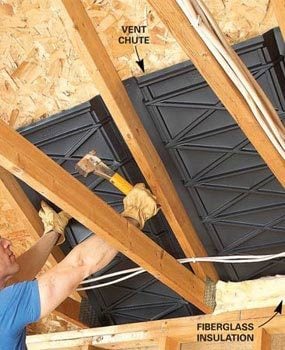
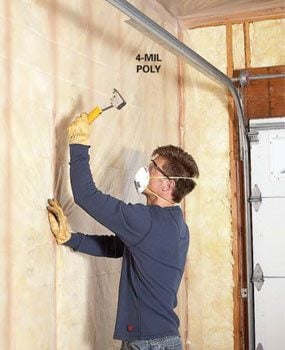
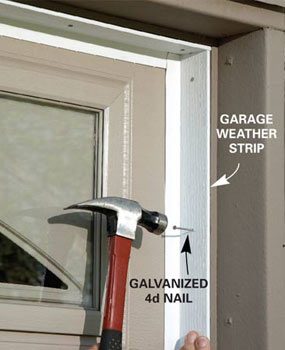

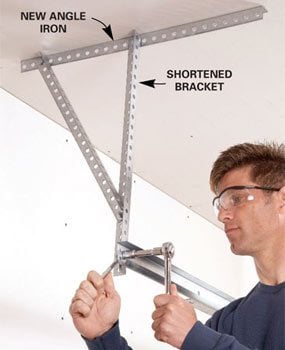
0 Response to "How To Finish A Garage Ceiling"
Post a Comment